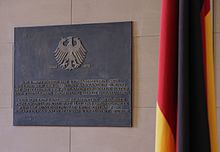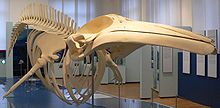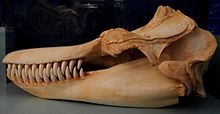Museum Koenig
 Main building on Adenauerallee (2014) |
|
| Data | |
|---|---|
| place |
Bonn |
| Art | |
| architect | Otto Penner , Gustav Holland , Julius Rolffs |
| opening | 1934 |
| Number of visitors (annually) | 123,000 |
| operator |
Foundation under public law
|
| management | |
| ISIL | DE-MUS-024813 |
The Zoological Research Museum Alexander Koenig (ZFMK) in Bonn is a natural history museum and a foundation under public law of the state of North Rhine-Westphalia . The museum building is located directly on the B9 on the outskirts of the Federal District , stands as a monument under monument protection and is a station of the historical round path towards democracy because on September 1, 1948 in the Great Hall of the Museum of the ceremony to mark the meeting of the Parliamentary Council was held.
As a member of the Leibniz Association, the museum is also the Leibniz Institute for Animal Biodiversity and is jointly financed by the federal and state governments. It specializes in recent vertebrates and arthropods . The research facility emerged from the private museum of the Bonn ornithologist and university professor Alexander Koenig , who transferred it to the Prussian state in 1929.
history
Founding history


In 1873 Leopold Koenig bought a villa built in 1860 on Coblenzer Strasse near his own residence in Bonn , now known as Villa Hammerschmidt , which he gave to his son Alexander in 1884 on the occasion of his doctorate in zoology and his wedding. Alexander Koenig used the upper floor exclusively for his zoological collection. From 1898 to 1900 he had an "ornithological museum" built north of the villa, based on the model of the museum by Walter Rothschild and plans by the Bonn architect Otto Penner , which housed his extensive ornithological collection. Koenig made several research trips, including to the Arctic and North Africa, and continued to expand his collection.
With the inheritance of his father, who died in 1903, Alexander Koenig planned a larger natural history museum based on the model of the Berlin Museum of Natural History . On September 3, 1912, the foundation stone of today's main building of the Alexander Koenig Museum was laid, which is directly connected to the private museum and for which some of the existing buildings (Koblenzer Straße 212–220) had to be demolished. The architect was Gustav Holland , a school friend of Koenig and court building advisor to the Prussian king; the reliefs and sculptures on the facade were created under the guidance and supervision of the Bonn sculptor Karl Menser , with the implementation partly in the hands of his former student Jakobus Linden . The construction company was Philipp Holzmann .
After the completion of the shell in the summer of 1914, the building was confiscated because of the First World War and used as a military hospital, after the end of the war initially from the end of 1918 by British and finally from 1920 to 1926 by French occupation troops (among the latter as Caserne Napoléon 1 er ) as a barracks and prison utilized. Due to the loss of assets due to the inflation of 1923 , Koenig was unable to continue the project as intended and on February 7, 1929, after lengthy negotiations about the continuation of the museum and research operations, transferred the museum to the German Reich . The execution of the remaining interior work was carried out as a representative of Gustav Holland by the Bonn architect and former government builder. D. Julius Rolffs . The museum was opened on May 13, 1934. From 1938, parts of the building were used as an air raid rescue center and by a security and emergency service.
After the Second World War
The Koenig Museum remained largely undamaged during World War II , but was closed to the public from 1943. The only exception was the burned-out villa (south wing), which was rebuilt in a simplified manner in 1949 with funds from the state of North Rhine-Westphalia. Since there were no other representative buildings available in Bonn, the ceremonial act for the meeting of the Parliamentary Council took place in the large hall (“atrium”) of the museum on September 1, 1948 . The prepared giraffes there were covered up because they could not be removed. The museum, which reopened on June 15, 1950, was expanded under the direction of Adolf von Jordans (1947–1957).
For a short time, the museum was the seat of the Federal Chancellery : After his election in September 1949, Konrad Adenauer used the museum as an office for two months - his study was the ornithological library, and cabinet meetings were held in the lecture hall. In addition, until 1957 the museum housed offices of several federal ministries in the rooms facing Adenauerallee , including the Federal Ministry for Affairs of the Marshall Plan , as before, parts of the Federal Chancellery (until 1955) and then the Foreign Office . In addition, a makeshift wooden skeleton construction was built at the rear of the Koenig Museum in 1950 , comprising 24 office rooms and housing the first office of the Blank office . For this reason, the museum is today one of the 18 stations on the “ Path of Democracy ”, with which Bonn's former government and today's federal district is opened up for historical and tourist purposes.
Since October 1, 1953 - when it was transferred by the Federal Republic of Germany - the Koenig Museum has been owned by the State of North Rhine-Westphalia. Due to Bonn's function as the seat of government and the presence of numerous embassies , some countries presented themselves in their own exhibitions at the Museum Koenig. During the construction work on the urban railway tunnel in the 1970s, cracks formed in the Museum Koenig, and it suffered further damage in an earthquake . The museum was entered in the monuments list of the city of Bonn in 1985. In the 1990s, the military hospital in the basement and the air raid shelter from the period between the First and Second World War were demolished. From 1998 to 2003 the main building was completely renovated according to plans by the Bonn architects Karl-Heinz Schommer . From 2003 to 2006 a rear extension was built ("Clas M. Naumann-Bau"); A four-year roof renovation was completed in 2012.
Today's museum


With around seven million specimens, the natural history collection of Museum Koenig is one of the largest in Germany. The museum is divided into three centers and four departments:
- Center for Taxonomy and Evolutionary Research with the departments of vertebrates and arthropods (arthropods)
- Center for Molecular Biodiversity Research
- Center for exhibition and public relations with the public relations and exhibitions departments
Both basic research in the field of systematics and activities in the field of education fulfill important socially relevant tasks.
In 2010 the museum employed 49 permanent employees (14 of them scientific) and 130 additional employees. Of these, 15 were scientists in externally funded projects, 100 undergraduate, post-graduate and state examination candidates, and 15 volunteers. Since 1949, the Koenig Museum has been one of the research institutions of supraregional importance financed jointly by the federal states , from which the Leibniz Association has developed. It has been a founding member of the Humboldt Ring since September 24, 2009 . On January 1, 2013, the Koenig Museum was transferred by a state law from a direct state institution to a foundation under public law.
Since 2004 (reopening in October 2003), the permanent exhibition entitled “Our Blue Planet - Life in the Network” has also reflected the shift in the research focus to biodiversity research . The aim of the permanent exhibition is to provide an insight into how large living spaces work. Large dioramas and staged, naturalistic landscape depictions are mainly used for this purpose. The exhibition is divided into the following parts:

- Savannah - the changeful paradise
- Rainforest - treasure trove of life
- Arctic / Antarctic - life in the polar ice world
- Central Europe - discover home
- Bird world - leading fascination
- Vivarium - living diversity
The staging of an African savannah in the atrium of the house is particularly impressive. In the naturalistic representation of this habitat with countless specimens, the interplay of the different living beings is understandable, especially for young visitors.
The exhibition “Rainforest - Treasure Chamber of Life” has been redesigned. On April 27, 2016, the first part of the ambitious concept entitled "Undergrowth" was opened. Again, the precise work of the museum's taxidermists is outstanding, ensuring a strikingly real-looking representation.
The museum has been marketing its exhibition together with neighboring institutions since 1995 as part of the Bonn Museum Mile .
collection
The collection focuses on:
- Collection of arachnids and arthropods (basal arthropods ) with about 70,000 copies, including the world's most comprehensive reference collection of jitter spiders
- Diptera collection (flies, mosquitoes etc.) with approx. 300,000 copies
- Coleoptera collection (beetles) with approx. 2,500,000 copies
- Hymenoptera collection (hymenoptera) with approx. 153,000 copies
- Lepidoptera collection ( butterflies ) with approx. 2,000,000 specimens, including approx. 600,000 Chinese butterflies
- Myriapoda Imagery ( millipedes , sphaerotheriida , glomerida , Wursttausendfüßer, Urtausendfüßer), with 15,000 copies
- ichthyological collection ( fish ) with approx. 100,000 copies
- herpetological collection ( amphibians and reptiles ) with approx. 100,000 copies
- ornithological collection ( birds ) with approx. 150,000 copies (including eggs, nests and skeletons)
- theriological collection ( mammals ) with approx. 100,000 individuals
Support association

The Alexander Koenig Society e. V. (AKG) aims to support the museum in its work and to arouse interest and understanding for the importance of zoological science and research and the museum's collections. The association supports research projects on topics of biodiversity, taxonomy, systematics, evolution and biogeography as well as projects in the field of nature conservation. AKG is the publisher of the Koenigiana magazine and supports the museum's public relations work. The company organizes lectures, does youth work under the title “Nature Inspires”, addresses mature people with the program “Want more knowledge”, organizes a painting competition for primary schools in the Bonn region, and a photo competition for amateur photographers. With the support of sponsors and mentors, the ZFMK's rainforest exhibition is being expanded and the museum is being promoted as an extracurricular learning location in Bonn for all types of schools.
Directors

The position of director of the Zoological Research Museum has been linked to the chair for special zoology at the Rheinische Friedrich-Wilhelms-Universität Bonn since 1989 . J. Wolfgang Wägele has been the current director of Museum Koenig since October 2004. Deputy directors are currently Bernhard Misof for the scientific field, the position of administrative management is currently vacant.
Predecessors in the director's office were:
- Alexander Koenig 1934–1940
- Adolf von Jordans 1948–1957
- Martin Eisentraut 1957–1967, provisional until 1969
- EG Franz Sauer 1969–1971
- Martin Eisentraut , provisional 1971–1977
- Günter Nobis 1977–1988
- Hubert Roer , 1988–1989
- Clas Michael Naumann zu Königsbrück 1989-2004, after whom the extension opened in 2006 was named
- Wolfgang Böhme , acting February 2004 to October 2004
- Wolfgang Wägele , 2004–2020
- Bernhard Misof, since May 1, 2020
Awards
In 2013, the research museum received the award for its German Barcode of Life Project (GBOL) project , the creation of the first comprehensive national genetic library of Germany's biodiversity , from the Minister for Innovation, Science and Research of the State of North Rhine-Westphalia, Svenja Schulze , the award Place of Progress in NRW . The award honors institutions that "innovatively combine economy, ecology and social issues and thus enable progress for society".
literature
- Maria Günther: The Zoological Museum Alexander Koenig and its creator . In: Bonner Heimat- und Geschichtsverein , Stadtarchiv Bonn (ed.): Bonner Geschichtsblätter: Yearbook of the Bonner Heimat- und Geschichtsverein , ISSN 0068-0052 , Volume 67 (2017), Bonn 2017, pp. 267–288.
- Andreas Denk , Ingeborg flag : Architectural guide Bonn . Dietrich Reimer Verlag, Berlin 1997, ISBN 3-496-01150-5 , p. 82.
Web links
Individual evidence
- ↑ List of monuments of the city of Bonn ( Memento of the original dated December 5, 2012 in the Internet Archive ) Info: The archive link was inserted automatically and has not yet been checked. Please check the original and archive link according to the instructions and then remove this notice. , P. 3, number A 873
- ↑ The Ornithological Museum , Zoological Research Museum Alexander Koenig
- ↑ Anniversary celebration - Museum Koenig turns 100 , on Rhein-Sieg-Anzeiger, from August 30, 2012, accessed on October 17, 2017
- ↑ Maria Günther: The Zoological Museum Alexander Koenig and its creator . In: Bonner Heimat- und Geschichtsverein , Stadtarchiv Bonn (Ed.) Bonner Geschichtsblätter: Yearbook of the Bonner Heimat- und Geschichtsverein , ISSN 0068-0052 , Volume 67 (2017), Bonn 2017, pp. 267–288 (here: p. 278 ).
- ^ Artist profile Karl Menser 1872 - 1929 , meeting point art
- ↑ Maria Günther: The Zoological Museum Alexander Koenig and its creator . In: Bonner Heimat- und Geschichtsverein , Stadtarchiv Bonn (Ed.) Bonner Geschichtsblätter: Yearbook of the Bonner Heimat- und Geschichtsverein , ISSN 0068-0052 , Volume 67 (2017), Bonn 2017, pp. 267–288 (here: p. 284 ).
- ↑ Horst-Pierre Bothien: Bonn sur-le-Rhin Occupation 1918-1926 (= City Museum Bonn : Forum History ., No. 14). morisel Verlag, Munich 2018, ISBN 978-3-943915-34-1 , p. 106.
- ^ A b Maria Günther: The Zoological Museum Alexander Koenig and its creator . In: Bonner Heimat- und Geschichtsverein , Stadtarchiv Bonn (Ed.) Bonner Geschichtsblätter: Yearbook of the Bonner Heimat- und Geschichtsverein , ISSN 0068-0052 , Volume 67 (2017), Bonn 2017, pp. 267–288 (here: p. 285 / 286).
- ^ City of Bonn, City Archives (ed.); Helmut Vogt : "The Minister lives in a company car on platform 4": The beginnings of the federal government in Bonn 1949/50 , Bonn 1999, ISBN 3-922832-21-0 , pp. 164-165, 167.
- ↑ 100 years of laying of the foundation stone - anniversary celebration ( Memento of the original from July 17, 2014 in the Internet Archive ) Info: The archive link has been inserted automatically and has not yet been checked. Please check the original and archive link according to the instructions and then remove this notice. , Museum Koenig.
- ↑ Reiner Pommerin : From Berlin to Bonn. The Allies, the Germans and the question of the capital after 1945 , Böhlau Verlag, Cologne 1989, ISBN 3-412-12188-6 , p. 182.
- ^ City of Bonn (ed.); Helmut Vogt: "The Minister lives in a company car on platform 4". The beginnings of the federal government in Bonn 1949/50 , Bonn 1999, ISBN 3-922832-21-0 , p. 249.
- ↑ General-Anzeiger , August 10, 1985, Bonn city edition, p. 4.
- ↑ Main building , Alexander Koenig Zoological Research Museum
- ^ Clas M. Naumann-Bau: Replacement and extension building , Zoological Research Museum Alexander Koenig
- ^ Museum Koenig: Adler shines in new splendor , General-Anzeiger , January 4, 2012
- ^ Annual report 2012 , Zoological Research Museum Alexander Koenig
- ↑ Law establishing a foundation "Zoological Research Museum Alexander Koenig - Leibniz Institute for Animal Biodiversity" of November 13, 2012
- ^ Arachnida and various Arthropoda | ZFMK - Zoological Research Museum Alexander Koenig. Accessed May 1, 2019 .
- ↑ Diptera (two-winged birds like flies and mosquitoes) | ZFMK - Zoological Research Museum Alexander Koenig. Accessed May 1, 2019 .
- ↑ Coleoptera (beetle) | ZFMK - Zoological Research Museum Alexander Koenig. Accessed May 1, 2019 .
- ^ Hymenoptera | ZFMK - Zoological Research Museum Alexander Koenig. Accessed May 1, 2019 .
- ↑ Collections | ZFMK - Zoological Research Museum Alexander Koenig. Accessed May 1, 2019 .
- ^ Myriapoda | ZFMK - Zoological Research Museum Alexander Koenig. Accessed May 1, 2019 .
- ↑ Ichthyology (fish) | ZFMK - Zoological Research Museum Alexander Koenig. Accessed May 1, 2019 .
- ↑ Herpetology (amphibians and reptiles) | ZFMK - Zoological Research Museum Alexander Koenig. Accessed May 1, 2019 .
- ↑ Ornithology (birds) | ZFMK - Zoological Research Museum Alexander Koenig. Accessed May 1, 2019 .
- ↑ Theriologie (mammals) | ZFMK - Zoological Research Museum Alexander Koenig. Accessed May 1, 2019 .
- ^ W. Böhme, In memoriam Günther Nobis (1921-2002) , in: Tier und Museum. Communications from the company the friends and patrons of the Alex Museum. Koenig , Vol. 8, Issue 1/2, Bonn 2002.
- ↑ The State Government of North Rhine-Westphalia Press of July 9, 2013: Minister Schulze names 19 “Places of Progress” in North Rhine-Westphalia / State Government recognizes innovative ideas from North Rhine-Westphalia , accessed on January 25, 2014




